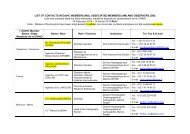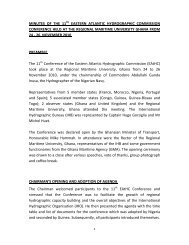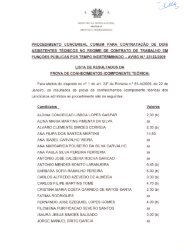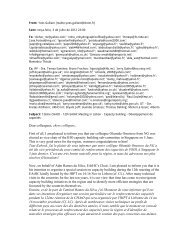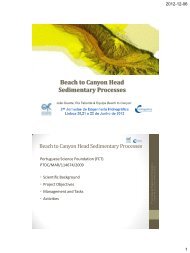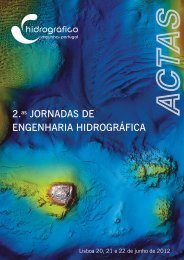You also want an ePaper? Increase the reach of your titles
YUMPU automatically turns print PDFs into web optimized ePapers that Google loves.
72 ANAIS DO INSTITUTO HIDROGRÁFICO N.º 15<br />
their variation), as they are delivered instantaneously by<br />
the corresponding commands. For the case of the point,<br />
it is made a comparison with the maximum value of the<br />
respective variable in the field. It is also available the wave<br />
data evolution along the isolines. The direct connection<br />
with the pre-processing stage permits a further extension<br />
from a two-point line to a path generated by many<br />
lines as the one in figure 8 and also to define the data<br />
distribution along any isoline without imposing these as<br />
an ‘a priori’ output request to the model.<br />
4.3 Spectral analysis<br />
The harmonic or spectral analysis is a technique<br />
that unravels the waves generated by different storms<br />
and describes the complete distribution of wave energies<br />
and periods. The 1D spectrum presents variance<br />
density per unit frequency interval for each frequency.<br />
The variance units are m 2 per frequency interval<br />
Ds, which can be converted into true energy through<br />
multiplication by rg/8, where r is the water density, and<br />
g is the acceleration of gravity. The total variance for<br />
each point can be obtained by summing the variance<br />
densities. The most complete description of waves is<br />
provided by a directional wave spectrum, which includes<br />
the direction of wave approach as well as the wave variance<br />
at a specific frequency. Such a 2D spectrum is<br />
given in the three-axis plot in figure 17. As it can be seen<br />
also in the command panel of figure 17, ‘TOTAL WAVE’<br />
provides both the 1D and 2D spectra and can be followed<br />
the evolution of the spectral shape towards to the shore.<br />
Moreover could be performed comparative analyzes<br />
between the spectral shapes in various places.<br />
4.4 The surf zone conditions<br />
The processes and the phenomena associated with<br />
the depth-induced wave breaking are particularly<br />
important in the coastal engineering applications. This<br />
because a great amount of the wave energy is finally<br />
dissipated in the nearshore regions determining the<br />
geometry and composition of the beaches and influencing<br />
the coastal structures and works. A rapid and<br />
adequate evaluation of the wave conditions in these<br />
areas being therefore of essential importance. For estimating<br />
the process of wave breaking SWAN, uses the<br />
spectral version of [Eldeberky and Battjes (1996)],<br />
expanded to include directions. In terms of energy dissipation<br />
the breaking process is associated with a significant<br />
increase. Once the breaking line is identified can be<br />
evaluated the wave data along its points. In figure 18 are<br />
presented some characteristics of the breaking as the<br />
variation in relationship with the shore of the distance<br />
where is initiated the wave breaking and the distributions<br />
of the significant wave height and the depth on the<br />
breaking line. The commands available for this module<br />
could be seen also in figure 18 and they are: identifying<br />
the location of the breaking line, determining the variation<br />
of the breaking ratio along it, evaluation of the<br />
breaking type, assessing the wave direction just before<br />
breaking, computation of the number of fronts in the<br />
surf and finally displaying the dissipation variation<br />
towards to the shore. The breaker-type prediction used<br />
the deep-water form of the Iribarren number (j ‘),<br />
which combine the beach slope with the wave steepness.<br />
In reference to this parameter the breaking-type classification<br />
is the following [Komar (1998)]:<br />
Point data Line data<br />
Fig. 15 – Global data evaluation Fig. 16 – Local data assessment







